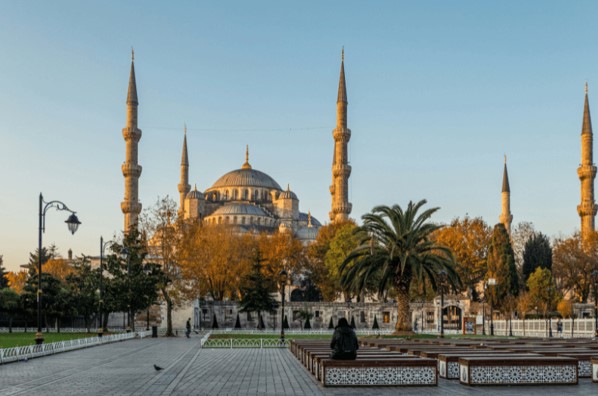The directions to Dunino Den read like the start of a Stephen King novel: Take the country road to the sandstone church with the spired bell tower. Walk to the end of the graveyard, where an unmarked trail slopes into the woods. Follow the path till it disappears into the ferns and find the staircase running like a crack in the bedrock. Descend into a sunken hollow hemmed by a meandering stream, where tattered ribbons, sachets of polished stones, and other offerings dangle from spindly tree branches like “Nightmare Before Christmas” ornaments. By Adam Erace
In Scotland, the boundary between the mortal and the mystical is historically porous, and after dark, disciples visit Dunino Den to conjure the energy that’s said to dwell there. But during the day, when the sun pierces the forest canopy and makes the moss slowly devouring the rocks and trees glow like black-light graffiti, you’re more likely to find foragers. And on this balmy spring morning, I’m visiting this ancient pagan altar in the region of Fife not for elves and spells but for ramps and chanterelles.
Situated across the Firth of Forth from Edinburgh and unspooling eastward to the North Sea, Fife is a Scrabble board of tidy farms countered by unruly, rippling seams of wilderness. In the mythic woods and wind-whipped coves, a renewed interest in wild edibles and a recent influx of culinary talent are contributing to an ascendant food and drink scene.
How Fife became Scotland’s ultimate food destination

I find neither magic nor food in Dunino Den, but both at dinner at the Crusoe, a welcoming pub and inn facing the sea in the village of Lower Largo. Sweet scallops with hazelnuts and crispy blood sausage open for duck lacquered in local honey, and warm date cake drowns in salty, sticky toffee sauce. Resurrected last year, the place is all stone walls and stained glass, brass mermaids and very good dogs, and the bedrooms upstairs are matchboxes; in one of them, I fall asleep to surf slamming the inn’s 18th-century foundation.
At breakfast in the Crusoe’s restaurant, a tall, bearded chef brings maple-drizzled pancakes bracketed by thick-cut bacon — fuel for a second foraging trek, this one in nearby Keil’s Den, a forest protected by the Woodland Trust. Chef Christopher Trotter, who has spent most of his life cooking and living in Fife, thinks our chances of finding ramps are strong.
“Wild foods were staples during the World Wars,” he says, boots crunching as we drop into the sunlit river gorge. “Rabbit, pigeon — it was all people had. So when you’re suddenly faced with something different, you reject that as poverty food. What’s happened is the sudden awareness of the quality in wild foods — and it’s fun to go out and harvest.” Especially when you find a colony of ramps poking out of the ground like green bunny ears. Scots call them wild garlic, and they’re as mad for them as we are in the USA. During my week in Fife aka the food destination of Scotland, I found them on menus everywhere. Ramp butter melts over a fire-grilled rib eye at the convivial Steak Barn in St. Andrews. Sautéed ramps are draped across delicate rabbit-and-sweetbread cannelloni at the lovely Michelin-starred Peat Inn. A bowl of ramp pesto enlivens stinging-nettle soup in the pumpkin-coloured kitchen of Trotter’s Largo farmhouse.

The bowls of soup and pesto are like green traffic lights on the table among Christopher’s cookbooks, fragrant cut hyacinths, and a seed-speckled loaf baked that morning by his wife, Caroline, a food photographer. Butter glides onto the whole-wheat bread, warmed by the light pouring in from the window, which faces a neat field and the Firth of Forth. “We’re actually bordered by water on three sides,” he says, noting the river Tay to the north. Both the river Forth and the Tay escape from inland lochs, twisting across the countryside as narrow capillaries, widening to unite with the North Sea and give Fife a nourishing embrace. So not only is the fishing phenomenal but “the soil is really good quality. Our farming traditions go back centuries.” Which is how an area less than half the size of Rhode Island came to be considered the larder of Scotland.
In this food destination of Scotland, I spend most of my time in the East Neuk. About a dozen seaside villages claim this corner of the region, each with its own personality, together forming a salt-crusted collage of modest harbours and ice cream parlours, elfin cottages and stately town houses with gulls plotting from the chimney pots. The towns dot short dashes of coast road like Morse code, making the region easy to visit and making you feel that you’re in a BBC seaside detective series where everyone knows everyone else.

Spend even a few days in the area, and you’ll start running into the same characters, especially in the East Neuk. To wit: I mention our stay at the Crusoe, and Trotter asks, “How did you like the breakfast?” A strange question until he adds, “My son Henry would have cooked it for you.”
Nobody in Fife can quite agree where the East Neuk officially begins. Some say Largo, where the Trotters live. Others name Elie, a tony enclave where Edinburgh lawyers keep summer homes, and where I keep my balance climbing the wave-gnashed headlands of Ruby Bay to the ruins of Lady’s Tower, built in 1770 as a swimming hut for Lady Janet Anstruther, a merchant’s wife.
From a culinary perspective, if not a geographical one, the East Neuk begins in St. Monans, at Bowhouse, a market hall housed in a former barn. If you come to this food destination in Scotland to eat, you’ll visit Bowhouse, either during its monthly artisanal food-and-crafts bazaar or on an off-market day, when I find no competition for the seasonally driven bakes at Bowhouse’s new café, Baern. Friends and business partners Hazel Powell and Giacomo Pesce are among the many passengers of the city-to-seaside pandemic pipeline who have traded Glasgow and Edinburgh, respectively, for Fife’s slower pace of life and deeper connection to community and food. “You don’t have to go anywhere to get ingredients,” Powell says, pointing to the picture window in the back of her café. “You can see the wheat fields just over there.” That wheat becomes flour for Baern’s caper-beaded ramp focaccia, lush bay-scented custard tarts, and insane sourdough chocolate-chip cookies.

Though Stephen Marshall and Lucy Hine have only lived in Fife for seven years, their early memories of the place are a long way from sourdough chocolate chips. “The week we moved here from Edinburgh in 2015, our local post office, bank, bookshop, and pub all closed down within a week,” Marshall says. “There was no industry here, so we started our own thing.” Futtle, their two-year-old business occupying a stable block at Bowhouse, is an organic nano brewery and natural-wine shop filled with houseplants, board games, and experimental fermentations. The brews shimmer with terroir: hogweed seeds mimicking orange and cardamom in the fluffy saison, seaweed adding salinity and umami to the gose and spiced rum. I navigate teal ziggurats of canned and cased beers and climb the slim metal ladder to the coolship, an open, shallow basin that’s essentially a pool party for indigenous yeast to congregate on beer wort and kick-start spontaneous fermentation; Futtle’s is the only coolship in Scotland.
Bowhouse occupies a tiny morsel of the Anstruther dynasty’s Balcaskie Estate, 5,000 acres of agriculture shepherded into organic production by its current steward, Toby Anstruther. Five minutes inland from Bowhouse is the Kinneuchar Inn, another of Balcaskie’s community touchpoints and the inviting 17th-century pub of my dreams. Dapper blue wainscoting. Chalkboard specials. Candles and a killer wine list. At dinner, I find that ex-Londoners Alethea Palmer, the manager, and James Ferguson, the chef, have written a résumé for Fife’s riches, where a heroic côte de boeuf from Balcaskie’s Lincoln Red cattle follows a bouquet of celery-like sea kale warmed in scallop butter.

The bones of Saint Andrew, the apostle, put St. Andrews, the city, on the map. Medieval believers made the perilous pilgrimage to Fife to view the holy relics, first at St. Rule’s Church, then in the colossal cathedral that absorbed it in six-turreted splendour. All that remains of the basilica is a breathtaking seafront skeleton, courtesy of the Protestant reformers who, in 1559, plundered its sacred treasure, along with its stone for building material.
Golf is a religion in Fife aka the food destination of Scotland
Golf is the religion that brings most people to St. Andrews today. I follow the polo-shirted players into Rusacks hotel, where royal-blue sofas with cherry piping flank a crackling fireplace, and wallpaper-lined bookcases look like they lead to secret passages. The 135-year-old property reopened last September following a 50-room addition and total redesign; confident blocks of colour and exuberant patterns now animate its cherished bones, much as the students of the University of St. Andrews make this historic city buzz.
For all the talk of golf, St. Andrews is really a town run by kids, like a better-mannered Children of the Corn. By day, they pack alumni Alex Longson and Juno Lee’s black-and-white CombiniCafé, where I squeeze in for a voluptuous chai latte dirtied with espresso made with beans from Edinburgh-based Machina. By night, they convene over vivid raspberry and sea-salted chocolate at Jannettas Gelateria, which has been scooping since 1908.

Late one afternoon, a group of art students drags me into a pop-up show, and I wind up carrying a watercolour crab into dinner at Rusacks’s rooftop restaurant, 18. Fitting that East Neuk crustacean is on the menu, paired with asparagus and pink grapefruit and followed by currant-jewelled venison terrine, a proud pistachio soufflé, and, eventually, a handsome suite overlooking the 18th hole of the hallowed Old Course. Under a continent of emerald velvet, I sleep like the dead. The restless ghosts said to haunt the decayed cathedral might consider booking a night.
Having stayed in an idiosyncratic inn and a historic hotel, I head 10 minutes south of St. Andrews to the Kittiwake, one of the four Nordic-cool cabins on Bonerbo Farm, to experience Fife’s roaring vacation-rental market. A massive mustard corduroy sectional and wood-burning stove anchor the two-bed, two-bath retreat, and I stock the kitchen with violet broccoli, heirloom apple juice, and other provisions from Falkland’s Pillars of Hercules, the charming farm-café-market that was founded by Bruce Bennett, Fife’s godfather of organic agriculture, in 1983. The restaurants in Fife are great, but the access to pristine ingredients means cooking on vacation here is also a joy.
Glass doors open to a hot tub and deck overlooking farmland that runs three miles (4.8 km) to the hazy blue shield of sea and sky. The town you can slightly make out at the coast’s edge is Anstruther (Toby’s ancestors again), home of the award-winning Anstruther Fish Bar. Their sustainably-sourced haddock and chips are terrific, but I’d argue that the chubby sausage roll and Bake Off–worthy Victoria sponge at Bread & Butter, a cosy café that opened in late 2020, should be the village’s new edible calling cards. I search the café’s vinyl collection for Frightened Rabbit albums; the Scottish band’s drummer, Grant Hutchison, has a new cider shop, Aeble, a few doors down.

“We came on holiday for a few days, found a house for sale and a shop for rent, and just took the plunge,” Grant’s wife and business partner, Jaye Hutchison, says. The sea drew them from Glasgow, but also “the sense of creativity and love for food and drink in the area.” They celebrated Aeble’s first anniversary in April. “We have no regrets.”
The existential question in Fife is how to balance a thriving tourist economy with a sustainable way of life. Darren Peattie, whose family has lived in the East Neuk for 400 years, tells me that “with housing prices climbing higher and higher, the local person will always be outplaced, and that, in ten years, will dramatically shape these villages.” He and his wife and partner, Mhairi Peattie, live and work in St. Monans, where a sold-out development of 46 attractive bungalows has sprung up along the coast road like mushrooms after rain. “We could never afford to live there.”
“Until we’re salt barons, of course,” Mhairi adds.

Inspired by St. Monans’s defunct saltworks, the couple crowdfunded East Neuk Salt Co. into life and began converting North Sea water into angular, glittering crystals in 2021. “Young people have to leave the East Neuk to find jobs,” Darren says. “We want to create them.” They’re launching a dinner series and seafood café at the harbour helmed by Mhairi, whose cooking I experience at the Dory Bistro & Gallery, in Pittenweem, where she delicately grills langoustines and launches crispy hake into luminous seaweed beurre blanc.
Historically in Scotland, seaweed was prized as an ingredient in ceramics and glass-making but snubbed as a food — the marine analogue to the puny game Christopher Trotter mentioned in Keil’s Den. “There was the connotation that if you’re eating it, you’re poor,” forager Jayson Byles tells me the next morning when we meet at a nameless beach guarded by a solitary white horse and the weather-eaten ruins of Newark Castle. “I think the only thing that’s stopping more people from foraging and eating seaweed is a little bit of knowledge.”

The New Zealander moved to Fife six years ago. His Maori heritage and professional culinary training converge in a deep reverence for the ocean, an attitude reflected in his hands-on East Neuk Seaweed workshops. The horse snorts as we open the gate and zigzag down to a shore where the tide has revealed a garden on the fingerlike jetties. During certain full and new moons the sea retreats even farther; on those days, Byles says, “You might be the only human walking there for 10,000 years.”
We crab-walk over the slick rocks, bladder wrack popping like Bubble Wrap, and collect threadlike sea spaghetti, tender sea lettuce, and maroon frills of pepper dulse, which taste like truffles. Byles builds a campfire in the nutmeg-coloured sand. I sauté the sea spaghetti with mushrooms and onions in a wok with kelp-infused sesame oil and ramp purée, while he sears local lemon sole in a cast-iron skillet. The conversation turns — as so many in Fife have — to the region’s relationship with newcomers.

“I used to do a lot of workshops on Kingsbarns Beach, the East Neuk’s best-kept secret. Last year I stopped because it was so busy. And that’s not necessarily a bad thing; it’s a real positive for local businesses that we get more visitors, but when you get the ones that leave their rubbish, it becomes a problem.”
On this beach, our only company is a lumbering Muppet of a Labradoodle walking his owners and a woman collecting whelks in a pink Adidas sweatshirt and matching polka-dot rubber boots. How long will it remain this way? How long before Byles needs to find the next best-kept secret?

Clear as they are, the tide pools don’t show the future, but Byles is certain food and education can support conservation — of the physical environment and of Fife’s community and culture. “Getting people out on the land, out on the coast, foraging their own food — that’s a way to make newcomers appreciate this place and give them the memories the seventh-generation locals have, so they become bonded to the area.” He collects our plates, and, of course, our trash, and pushes cool sand over the smouldering charcoal. We leave no trace behind.
Sample Fife’s Culinary Harvest
Where to stay
Bonerbo Farm: Refreshingly minimalist, boxcar-like lodges on a working grain farm just outside Anstruther.
The Crusoe: Once a creaky seafront granary, this atmospheric inn in Lower Largo has super-snug rooms and a terrific restaurant.
Mangle Cottage: A stone cottage transformed into a beachy rental in Pittenweem.
Rusacks St. Andrews: Recently renovated and reopened under the Marine & Lawn banner, this historic property overlooks St. Andrews’s famous Old Course and West Sands Beach.
Where to eat and drink
Aeble: This keenly edited bottle shop in Anstruther features ciders and other fermentations from around the world.
Anstruther Fish Bar: An award-winning fish-and-chips shop on a scenic harbour.
Baern: Creative, seasonally focused bakes at Bowhouse, in St. Monans.
Bread & Butter: A charming Anstruther café-bakery beloved by locals.
CombiniCafé: Sleek Japanese- and Korean-inspired café from university alums in St. Andrews.
Dory Bistro & Gallery: A friendly seafood specialist in Pittenweem that sources directly from the fishers just outside.
18: Superb cooking, Scottish ingredients, and gorgeous views from the top of the Rusacks hotel.
Futtle: Genre-bending beers and brews, plus vinyl and board games, at Bowhouse, in St. Monans.
Jannettas Gelateria: Legendary gelato shop whose scoops are found all over Fife; the original is in St. Andrews.
Kinneuchar Inn: A handsomely renovated restaurant near the Balcaskie Estate, in Kilconquhar.
Peat Inn: Fife’s Michelin-starred gem is refined but not fussy.
Pillars of Hercules: One of the first organic farms in Falkland has an adorable grocery and café.
Steak Barn: Steaks from estate-raised beef, served on picnic tables in a former sawmill in St. Andrews.
What to do
Bowhouse: Monthly market weekends draw huge crowds to this converted barn in St. Monans. bowhousefife.com.
East Neuk Seaweed: Jayson Byles leads all-ages harvesting walks on the beaches of the East Neuk. eastneukseaweed.com.
Tours by Christopher Trotter: Foraging strolls, culinary workshops, and more,hosted by the longtime chef and man-about-Fife. christophertrotter.co.uk.
This story first appeared on www.travelandleisure.com
(Main and Feature Image Credit: Murray Orr)
Related: Fashion Plates: How Luxury Brands Open Restaurants All Over The World




More Stories
Top 5 Cafe around Sudirman Worth a Visit
KC named one of the best places in America to travel
At Urban Hawker in New York, Singapore street food gets a new HQ